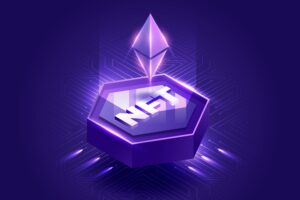A Guide to Buying NFTs: Understanding the Core Reasons
In recent years, the world of digital assets has experienced a significant evolution with the rise of Non-Fungible Tokens (NFTs). These unique digital assets have gained widespread attention, attracting both investors and art enthusiasts alike. If you are considering investing in NFTs or simply want to understand the core reasons behind their popularity, this guide will provide you with valuable insights into the process of buying NFTs and the underlying reasons driving this burgeoning market.

Understanding NFTs: A Brief Overview
Before delving into the process of purchasing NFTs, it is essential to grasp the fundamental concept of what NFTs are and how they differ from traditional cryptocurrencies. Unlike cryptocurrencies such as Bitcoin or Ethereum, which are fungible and can be exchanged on a one-to-one basis, NFTs are unique digital assets that represent ownership or proof of authenticity of a specific item or piece of content. This uniqueness is made possible through blockchain technology, which ensures the scarcity and indivisibility of each NFT.
The Core Reasons Behind the Popularity of NFTs
The growing popularity of NFTs can be attributed to several key factors that have contributed to their widespread adoption and appeal. Understanding these core reasons is crucial for anyone looking to venture into the world of NFT investments or digital collectibles.
Digital Ownership and Authenticity
One of the primary drivers behind the rise of NFTs is the concept of digital ownership and authenticity. NFTs enable individuals to assert ownership over digital assets, whether it be artwork, music, videos, or virtual real estate. This concept has revolutionized the way digital content is perceived, providing creators with a means to establish provenance and authenticity for their work in the digital realm.
Decentralization and Transparency
Blockchain technology, which underpins NFTs, offers a decentralized and transparent framework for recording ownership and transaction history. This transparency ensures that the provenance of an NFT can be easily verified, providing buyers with confidence in the authenticity and scarcity of the digital asset they are acquiring.
Diversification of Investment Portfolios
For investors, NFTs represent a novel opportunity to diversify their investment portfolios beyond traditional asset classes such as stocks, bonds, and real estate. The potential for significant returns on investment, coupled with the allure of owning unique digital collectibles, has attracted a new wave of investors seeking exposure to this emerging asset class.
Empowerment of Creators and Artists
NFTs have empowered creators and artists by providing them with a direct avenue to monetize their digital creations without relying on intermediaries or traditional gatekeepers. This democratization of the creative economy has enabled artists to reach a global audience and receive fair compensation for their work, thereby reshaping the dynamics of the art and entertainment industries.

How to Buy an NFT: A Step-by-Step Guide
Now that we have explored the core reasons driving the popularity of NFTs, let’s delve into the practical steps involved in purchasing an NFT. While the process may vary slightly depending on the platform or marketplace you choose, the following general steps outline the typical procedure for buying an NFT:
Step 1: Choose a Reputable NFT Marketplace
Selecting a reputable NFT marketplace is crucial to ensuring a safe and seamless buying experience. Platforms such as OpenSea, Rarible, and Foundation are popular choices that offer a diverse range of NFTs across various categories.
Step 2: Set Up a Digital Wallet
Before purchasing an NFT, you will need to set up a digital wallet that is compatible with the blockchain network hosting the NFT you intend to buy. Popular wallet options include MetaMask for Ethereum-based NFTs and Trust Wallet for Binance Smart Chain-based NFTs.
Step 3: Fund Your Digital Wallet
Once your digital wallet is set up, you will need to fund it with the relevant cryptocurrency (e.g., Ethereum for Ethereum-based NFTs) to facilitate the purchase. Ensure that you have sufficient funds in your wallet to cover the cost of the NFT as well as any associated gas fees.
Step 4: Browse and Select an NFT
Explore the marketplace to browse through the available NFTs and select the one that aligns with your preferences and investment goals. Pay close attention to factors such as rarity, creator reputation, and overall aesthetic appeal when making your selection.
Step 5: Place Your Bid or Make a Purchase
Depending on the marketplace’s mechanics, you may have the option to place a bid on an NFT through an auction format or directly purchase it at a fixed price. Follow the prompts provided by the platform to finalize your transaction and confirm your ownership of the NFT.
Step 6: Transfer Your NFT to Your Digital Wallet
Upon completing the purchase, transfer the acquired NFT from the marketplace to your digital wallet to secure ownership and retain control over your digital asset.
Key Considerations When Buying NFTs
While buying an NFT can be an exciting venture, it is important to approach the process with a discerning mindset and consider the following key factors:
Conduct Due Diligence
Before investing in an NFT, conduct thorough research on the underlying asset, its creator, and the marketplace where it is being sold. Verifying the authenticity and provenance of the NFT is essential to making informed investment decisions.
Beware of Market Speculation
The NFT market is susceptible to speculation and hype, which can lead to volatile price fluctuations. Exercise caution and refrain from succumbing to FOMO (Fear of Missing Out) when making purchasing decisions.
Consider Long-Term Value
Evaluate the long-term potential and value proposition of the NFT you intend to purchase. Look beyond short-term trends and assess whether the digital asset holds intrinsic value or has the potential for appreciation over time.
Understand Gas Fees and Transaction Costs
Be mindful of the associated gas fees and transaction costs when buying and selling NFTs, as these expenses can impact the overall cost and profitability of your transactions.
Conclusion
The emergence of NFTs has ushered in a new era of digital ownership, creativity, and investment opportunities. Understanding the core reasons behind the popularity of NFTs, coupled with a comprehensive grasp of the buying process and key considerations, is essential for anyone looking to navigate this dynamic and evolving landscape. Whether you are an investor seeking diversification or an artist exploring new avenues for monetization, the world of NFTs presents a myriad of possibilities that continue to shape the future of digital assets and creative expression.
FAQ’s
- What are NFTs?
NFTs (Non-Fungible Tokens) are unique digital assets representing ownership of a specific item or piece of content, like artwork, music, videos, or virtual land. Unlike fungible cryptocurrencies, each NFT is one-of-a-kind.
- Why are NFTs so popular?
Their popularity stems from various factors: digital ownership and authenticity, decentralization, investment potential, and empowering creators. They offer new ways to collect, invest, and engage with digital assets.
- Is buying NFTs safe?
While the technology is secure, the NFT market can be volatile and susceptible to scams. Research before buying, choose reputable marketplaces and practice caution.
- How do I buy NFT?
- Choose a reputable NFT marketplace (OpenSea, Rarible, Foundation).
- Set up a compatible digital wallet (MetaMask, Trust Wallet).
- Fund your wallet with the required cryptocurrency.
- Browse collections, research the NFT you want, and consider its authenticity and value.
- Place a bid or purchase directly at the listed price.
- Transfer the NFT to your wallet for secure ownership.
- What are gas fees?
Gas fees are transaction costs within the blockchain network needed to process NFT purchases. They can vary depending on network activity.
- What are some key considerations when buying NFTs?
Do your research, understand the project and creator, assess long-term value, beware of hype and speculation, and be aware of gas fees and potential risks.
- How can I avoid scams?
Never share your private keys, be cautious of giveaways and unrealistic promises, research projects thoroughly, and avoid investing more than you can afford to lose.
- What are some common NFT scams?
Fake NFTs, rug pulls (abandoning projects after raising funds), phishing attacks, and pump-and-dump schemes.
- Where can I learn more about NFTs?
Many online resources like blogs, articles, tutorials, and educational platforms (Investopedia, CoinMarketCap) offer in-depth information about NFTs and the underlying technology.
- Are there any communities for NFT enthusiasts?
Online forums, social media groups, and Discord servers offer communities to connect with other NFT collectors, creators, and investors.

